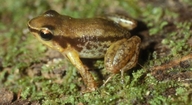|
Hyloxalus craspedoceps (Duellman, 2004)
| family: Dendrobatidae subfamily: Hyloxalinae genus: Hyloxalus |
| Species Description: Duellman, W.E. 2004. Frogs of the genusColostethus(Anura; Dendrobatidae) in the Andes of northern Peru.Scientific Papers of the Natural History Museum of the University of Kansas35: 1-49. | |
 © 2004 Natural History Museum and Biodiversity Research Center, The University of Kansas (1 of 2) |
|
|
|
Description A tadpole in Stage 34 has a body length of 10.0 mm and a total length of 25.3 mm; the body is ovoid, wider than high. The snout is rounded in dorsal view and in profile. and the moderately large eyes are situated dorsally, directed dorsolaterally, and not visible from below. The spiracle is sinistral, with the tube being short and attached to the body throughout its length. The spiracular opening is directed posteriorly just below the midline at about the midlength of the body. The cloacal tube is dextral, short, cone-shaped, and attached to the ventral fin. Caudal musculature is robust, equal in height throughout the proximal one-third of the tail, and gradually diminishes to a pointed tip. The dorsal fin originates on the caudal musculature, is highest at about two-thirds the length of the tail, and gradually diminishes to an acutely rounded tip. The ventral fin originates on the body and is highest at about three-fifths the length of the tail. The oral disc is directed anteroventrally, with the median half of anterior labium being bare; elsewhere the labia bear a single row of moderately long, pointed marginal papillae. The labia have shallow lateral folds. Submarginal papillae are absent. The jaw sheaths are slender and finely serrate. The anterior sheath is in the form of a broad arch, while the posterior sheath is broadly V-shaped. The labial tooth row formula is 2(1)/3, with row A2 slightly longer than the other rows. In life, the body and tail are gray. In preservative, the dorsum and sides of the body are brown, the belly is cream, the caudal musculature is pale creamy tan with small, irregular brown spots, and the caudal fins are translucent with brown spots; guanophores are scattered on the body and tail. Distribution and Habitat Country distribution from AmphibiaWeb's database: Peru
Life History, Abundance, Activity, and Special Behaviors Older, free-living tadpoles in Stages 25–35 were found in pools in a rocky stream. Comments
References
Duellman, W. E. (2004). ''Frogs of the genus Colostethus (Anura; Dendrobatidae) in the Andes of northern Peru.'' Scientific Papers of the Natural History Museum, University of Kansas, 35, 1-49. Santos, J. C., Coloma, L. A., Summers, K., Caldwell, J. P., Ree, R., and Cannatella, D. C. (2009). ''Amazonian amphibian diversity is primarily derived from late Miocene Andean lineages.'' PLoS Biology, 7(3), e1000056. Originally submitted by: William Duellman (first posted 2004-12-10) Edited by: Kellie Whittaker (2009-09-21) Species Account Citation: AmphibiaWeb 2009 Hyloxalus craspedoceps <https://amphibiaweb.org/species/6356> University of California, Berkeley, CA, USA. Accessed Jan 7, 2025.
Feedback or comments about this page.
Citation: AmphibiaWeb. 2025. <https://amphibiaweb.org> University of California, Berkeley, CA, USA. Accessed 7 Jan 2025. AmphibiaWeb's policy on data use. |


 Map of Life
Map of Life